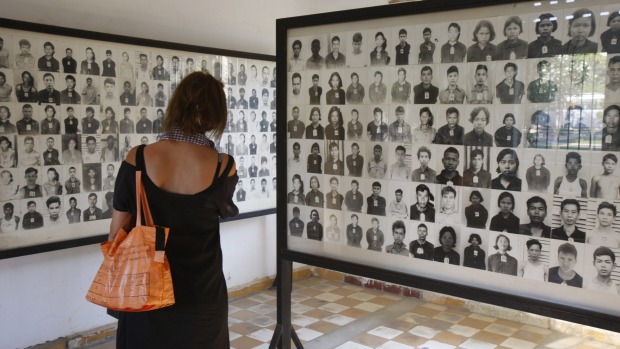
If you'd spotted the shrivelled old man leaving a side room of the museum, you might well have made the same mistake I did. My immediate thought is that he's an art restorer, or even a cleaner finishing his shift. However by the time I shake his hand at the end of our museum tour, I know all about Chum Mey.
Now 83, Chum Mey is one of seven adults to survive Tuol Sleng Prison. How many innocent people died in Tuol Sleng, or S-21? It's subject to debate. But the death toll was at least 12,000.
Every victim who arrived at S-21 endured the most extreme forms of torture and were made to document their entire family tree. Once their forced confessions were signed, the torture victims either died in S-21 or were taken by truck to the nearby Killing Fields where they were forced to dig their own graves.
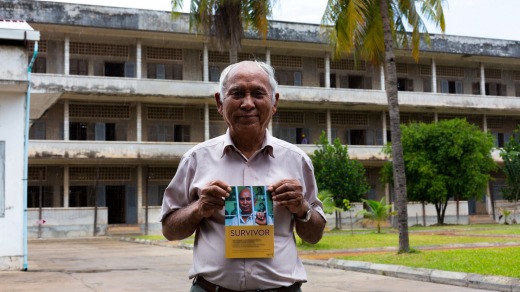
Yes, we're in Cambodia, and we're talking about Pol Pot's infamous Khmer Rouge regime which ruled the country from 1975-79.
You may wonder what this has to do with a luxury cruise along the Mekong river. But this is a debate which has raged aboard the Aqua Mekong since we left Ho Chi Minh City.
Two thirds of the passengers – including a senior Australian journalist and an erudite Italian businessman – are appalled that a handful of us want to visit Tuol Sleng (now known as the Genocide Museum) and the Killing Fields.
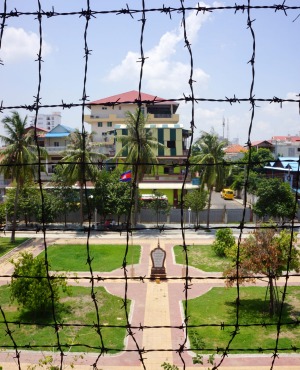
"These aren't tourist attractions, they're scenes of terrible crimes against humanity," says one.
That's a pretty strong argument. So what response do those of us who chose to visit Tuol Sleng have? Is it ever morally defensible to visit something like the Killing Fields? What, possibly, could be the case for the defence?
Chum Mey himself. He's one of two S-21 survivors who drag themselves most days to the place where they were tortured to sell the books which supplement their meagre pensions.
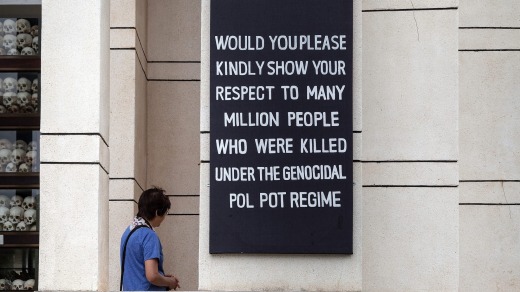
He was a car mechanic, married with four children, when he was arrested on October 28, 1978 and taken to S-21. He suffered numerous beatings, had a finger deliberately broken, and a big toe nail pulled out during the interrogations. How did he survive? Because he could fix a typewriter.
One day his torturers came to him, carrying the typewriter. Chum Mey had never mended a typewriter before but knew it was his only route of salvation.
Like the Nazis, the Khmer Rouge were mass murderers with meticulous record keeping skills. Chum Mey's interrogators needed to type up the "confessions" they extracted. Each confession listed the victim's family and circle of friends because Pol Pot believed it was safer to kill entire families rather than risk revenge.
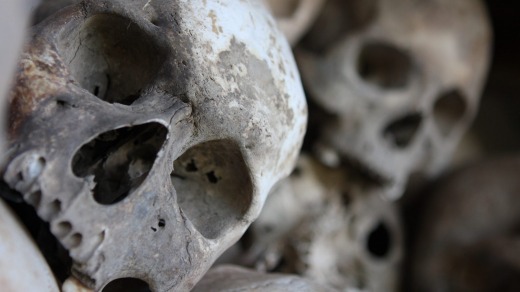
Chum Mey's tiny cell was 022 in C Block. He endured it for four months and 12 days until the invading Vietnamese army closed in on S-21 and he escaped.
Our young guide, Daleth, wasn't born in 1975. But her mother, Diep, was one of the millions forced to flee Phnom Penh in the first hours of the Pol Pot regime.
Diep and the others were told to flee. Their city was about to be carpet bombed by the Americans.
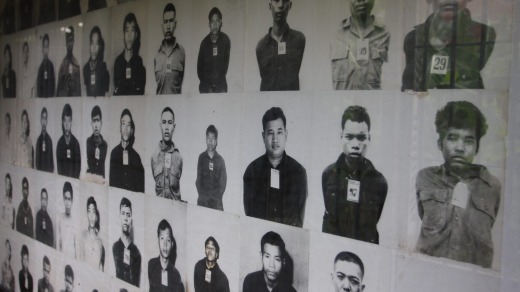
Of course, it was a lie. Pol Pot wanted the cities emptied to begin Year Zero.
Diep barely survived but returned to Phnom Penh when Pol Pot was overthrown, eventually getting a job at S-21 as a cleaner, then a guide.
Through her daughter, Diep explains S-21 began life in 1962 as a high school. What was conceived as a place of learning, hope and ambition became synonymous with terror, injustice and despair.
Our tour begins in Building A, where the highest ranking prisoners were kept. A typical cell here consisted of an iron bed to which the prisoner was shackled 24 hours a day, and a toilet box. Electrocution was one of the torture tactics used. So too was suspending prisoners from the hanging post outside, with their arms stretched backwards, placing intolerable pressure on their shoulders.
The torture methods have all been immortalised in a gruesome series of paintings by another S-21 survivor, Vann Nath. His passport to survival was even more bizarre than Chum Mey's mechanical skills. Vann Nath – who died in 2011 – could paint a good likeness of Pol Pot.
Much of Building B is given over to photographs of the Khmer Rouge leaders and hundreds of photos of their victims, taken in the first hours of their arrest.
Building C has curtains of barbed wire along each upper floor veranda. In 1976, a female prisoner managed to commit suicide by jumping from the second floor. The barbed wire was erected soon afterwards to ensure no one "escaped" again.
The Killing Fields. Some 343 Killing Fields have been identified across Cambodia. The most infamous – because it's 15 kms from the centre of Phnom Penh – is Choeung Ek.
At least 17,000 men, women, children and babies were killed here, arriving on regular trucks from S-21 prison. The centre is a 17-storey, glass-walled stupa from which the eyeless sockets of 8000 skulls look out, challenging the visitor to dare forget how they died.
The best way to visit? At your own pace, using the superbly designed audio guides. They include translated interviews from eye witnesses including guards and "Comrade Duch", commander of S-21 and the first Khmer Rouge war criminal to be convicted of crimes against humanity.
Of all the monstrosities at Choeung EK, the most emotionally harrowing is The Killing Tree. Here, mere babies had their heads smashed against the tree so as not to "waste" bullets. Uplifting Khmer Rouge battle songs would blare out throughout the crudest of mass murders, drowning the pitiful cries, and disguising the Hades-like reality from the local villagers.
This entire debate, about the rights and wrongs of visiting uncomfortable "tourist attractions" had been sparked on the first day of our cruise.
A Texan couple said there had been nothing of interest to see in Ho Chi Minh City, so they had stayed in their hotel.
When I had protested, they'd labelled me naive. "Why would we go and see the Cu-Chi Tunnels or the War Remnants Museum? They're just propaganda against Americans," they'd said.
But aren't the Cu-Chi Tunnels part of America's 20th Century history as much as Vietnam's? And though the War Remnants Museum was definitely one-sided when I first visited it in 1995, it has been considerably improved since.
Sure, there's nothing critical of Ho Chi Minh, the Vietcong, or the subsequently authoritarian communist regime.
Yet now there's ample comment from substantial US statesmen (even an apologetic Robert McNamara, the then US Defence Secretary). Plus a forceful display on the effects of Agent Orange and other forms of chemical warfare, and a truly unforgettable visiting photographic exhibition of the Vietnam war shot almost entirely by US photo-journalists.
Dachau, Yad Vashem, Auschwitz...
I learned about the Holocaust in that order.
Aged 18, I was on my way to Munich's Octoberfest when I took a detour to Dachau, the first of the Nazi's concentration camps to be liberated by the Western armies in 1945.
Five years later, I took a few months off work to volunteer for a kibbutz in Israel. Most of the Jewish elders on the kibbutz were either veterans of WWI or WWII. On a weekend off in Jerusalem, I went to the Yad Vashem Holocaust Museum to pay homage. I emerged, shaken and breathless...
In 1993 I went to Krakow, Poland's second-largest city, shortly after the release of Steven Spielberg's film Schindler's List (based on Thomas Keneally's Booker prize-winning Schindler's Ark). I was keen to see what remained of Oscar Schindler's Krakow –including Auschwitz itself, an hour's drive west of Krakow.
Today all sorts of Auschwitz tours have grown up. But back then the Poles didn't encourage visitors to make the pilgrimage. Yet I challenge anyone to enter under that famous sign Arbeit macht frei (Work makes you free) and not feel that empathy with those who died.
The Kigali Genocide Memorial Centre in Rwanda, the Hiroshima Peace Memorial Museum in Japan, the Museum of Memory and Human Rights in Chile, the Armenian Genocide Museum in Yerevan, the Apartheid Museum in South Africa, the Nanjing Massacre Museum in China, even the September 11 Memorial Museum in New York....
Sadly, I have never been to any of them. Even more sadly, those atrocity memorials keep growing, year by year.
But what do you think?
Ultimately, are we wiser for visiting them – even if the experience is never comfortable?
Or should we, as "tourists", leave such terrible blemishes of human character to one side while we explore temples and palaces (and how were they financed?).
www.aquaexpeditions.com
Vietnam Airlines offers daily return flights from Ho Chi Minh City, with connections to and from Siem Reap or Phnom Penh, with transfers to the Aqua Mekong. If you are joining or departing in Phnom Penh, Vietnam Airlines operates three flights a day between Ho Chi Minh City and Phnom Penh. See www.vietnamairlines.com.
Aqua Expeditions operates three, four and seven-night adventures between Ho Chi Minh City and Siem Reap (or vice versa). Cruises include transfers to and from the vessel and meeting points in Ho Chi Minh City and Siem Reap, beverages (non-alcoholic, house wine and beer) and entrance fees en route. Phone 1800 243 152, see www.aquaexpeditions.com